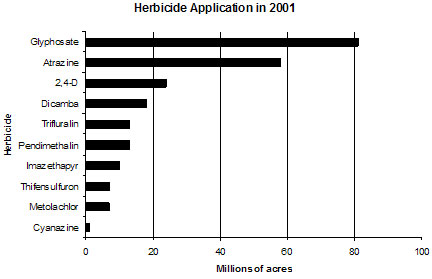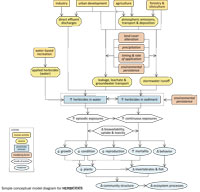CADDIS Volume 2: Sources, Stressors & Responses
Herbicides
Herbicides are chemicals used to manipulate or control undesirable vegetation. The most frequent application of herbicides occurs in row-crop farming, where they are applied before or during planting to maximize crop productivity by minimizing other vegetation. They also may be applied to crops in the fall, to improve harvesting. Herbicides are used in forest management to prepare logged areas for replanting; the total applied volume and area covered is greater but the frequency of application is much less than for farming (Shepard et al. 2004). In suburban and urban areas, herbicides are applied to lawns, parks, golf courses and other areas. Herbicides are applied to water bodies to control aquatic weeds that impede irrigation withdrawals or interfere with recreational and industrial uses of water (Folmar et al. 1979).
The potential effects of herbicides are strongly influenced by their toxic mode of action and their method of application. The molecular site of action is challenging to predict because structural associations have not been identified (Duke 1990), but modes of action are well-established. Herbicides can act by inhibiting cell division, photosynthesis, or amino acid production or by mimicking natural auxin hormones, which regulate plant growth, and causing deformities in new growth (Ross and Childs 1996). Methods of application include spraying onto foliage, applying to soils, and applying directly to aquatic systems.
Figure 1 and Table 1 present the ten herbicides most used on agricultural land in the U.S. Glyphosate and atrazine were applied to more than double the crop field acreage than the third leading herbicide, 2,4-D, in 2001.

Reproduced from www.ers.usda.gov/Briefing/AgChemicals/pestmangement.htm.
| Herbicide | Common Application | Mode of Action |
|---|---|---|
| Amino Acid Inhibitors | ||
| Glyphosate Roundup, Ultra, Rodeo, TouchDown Pro, Accord |
Applied primarily to genetically engineered, glyphosate-resistant varieties of soybeans, corn, canola and cotton. Also applied to control woody plants. Because of its broad spectrum and relatively low toxicity to animals, it has a variety of uses in horticulture and in the control of emergent and submerged aquatic macrophytes. | Applied to the foliage and transported with sugars to metabolic sites where they inhibit amino acid production. Effects will manifest in two or more weeks as discoloration of foliage and deformations in new growth. |
| Imazethapyr Pursuit |
Applied to control weeds in alfalfa, barley, soybeans, and wheat. | |
| Thifensulfuron Beacon, Pinnacle, Harmony |
Applied to control weeds in small grains, soybeans, and corn and in conifer and hardwood plantations. | |
| Photosynthesis Inhibitors | ||
| Atrazine Aatrex, Atrazine |
Applied to crops such as corn, soybeans and sorghum, particularly for conservation tillage. | These broad spectrum herbicides are applied at the soil and carried to the leaves by transpiration. They inhibit photosynthesis. |
| Cyanazine Bladex/DuPont |
||
| Synthetic Auxin, Growth Regulators | ||
| 2,4-D | Applied to broad-leafed weeds in corn, small grains, sorghum, pastures and rangeland. Urban use on lawns and grassy rights of way. Also applied for control of broad-leafed trees when planting conifers. | These synthetic growth hormones are applied to the foliage of dicots and transported to meristems causing uncontrolled growth. Effects can be observed as discoloration of foliage and deformations in new growth. They are fast acting: effects on foliage are visible within minutes of application. |
| Dicamba Banvel, Clarity, Vanquish, Veteran |
||
| Cell Division Inhibitors | ||
| Trifluralin Treflan and others |
Applied to control grasses and broadleaf weeds in crops such as beans, peanuts, cotton and tobacco. | These herbicides are applied to the soil to control target vegetation before emergence by inhibiting root growth. |
| Pendimethalin Prowl, Pentagon, Pendulum, Stomp |
||
| Metolachlor Dual, Dual Magnum, Pennant Magnum |
Applied pre-planting to control annual grasses and broadleaf weeds among crops such as corn and soybeans. | This herbicide is applied to the soil to control target vegetation by inhibiting or disrupting cell division in shoots. |
Herbicides may cause biological impairments of water bodies if they occur in water or sediment at sufficient concentrations. Most commonly, they enter surface water in runoff or leachate, but, because they have relatively low toxicity to fish and invertebrates (Table 2), acute toxicity is likely only when they are deliberately or accidentally applied directly to water bodies. Direct applications may result in direct toxicity to non-target plants and animals or indirect effects due to the death and decomposition of plants. Impairments also are more likely when herbicides are applied together or with other pesticides (Streibig et. al. 1998), resulting in additive or synergistic effects. Tests using the earthworm Eisenia fetida show that atrazine reacts synergistically with chlorpyrifos, an organophosphate insecticide: the mixture is seven times more toxic than the two individual pesticides (Lydy and Linck 2003). Atrazine has been shown to increase the effects of other pesticides in mosquito larvae, fruit flies, houseflies, and midge flies (Belden and Lydy 2000, Lydy and Linck 2003). The surfactants used in herbicide solutions also can be toxic to biota and are not considered when testing active ingredients (Folmar et al. 1979).
| Herbicide | Taxa | Biological Effect |
|---|---|---|
| Glyphosate | Water flea Daphnia magna |
Acute 48h EC50 is 218 mg/L (ECOTOX) |
| Amphipod Gammarus pseudolimnaeus |
Acute 48h EC50 is 42-62 mg/L (ECOTOX) | |
| Buzzer midge Chironomus plumosus |
Acute 48h EC50 is 55 mg/L technical glyphosate and 13mg/L Roundup® surfactant (Folmar et al. 1979) | |
| Mayfly Ephemerella walkeri |
Avoided Roundup® at 10 mg/L but not 1.0 mg/L (Folmar et al. 1979) | |
| Channel catfish Ictalurus punctatus |
Acute 96h LC50 is 130mg/L technical glyphosate and 13mg/L Roundup® surfactant (Folmar et al. 1979) | |
| Fathead minnow Pimephales promelas |
Acute 96h LC50 is 97mg/L technical glyphosate and 1.0 mg/L Roundup® surfactant (Folmar et al. 1979) | |
| Rainbow trout Oncorhynchus mykiss |
More sensitive response to Roundup® at elevated temperatures and at pH as it rises from 6.5 to 7.5, with no increased sensitivity at pH beyond 7.5 (Folmar et al. 1979) | |
| Bluegill sunfish Lepomis macrochirus |
||
| American ribbed fluke snail Pseudosuccinia columella |
Continuous exposure across generations produced reproductive effects on the third generation including rapid embryonic development, embryonic abnormalities, and increased egg laying (Tate et al. 1997) | |
| Atrazine | Midge Labrundinia pilosella |
Reduced emergence at 20 ug/L (Dewey 1986) |
| Cream and brown microcaddisfly Oxyethira pallida |
Shift in emergence period at 20 ug/L (Dewey 1986) | |
| Non-predatory insects | Reduced abundance at 20 ug/L (Dewey 1986) | |
| Stonewort algae Chara sp. |
Resistant to atrazine up to 100 ug/L (Dewey 1986) | |
| Tiger salamander Ambystoma tigrinum sp. |
Increased larval stage duration, reduced weight and body size (Larson et al. 1998) | |
| Hydra sp. | 48 hr LC50 of 3,000 ug/L (lowest acute value) (U.S. EPA 2003) | |
| Goldfish Carassius auratus |
96 hr LC50 of 60,000 ug/L (highest acute value) (U.S. EPA 2003) | |
| Water flea Ceriodaphnia dubia |
Life cycle chronic value of 3,536 ug/L (highest chronic value) (U.S. EPA 2003) | |
| Brook trout Salvelinus fontinalis |
Life cycle chronic value of 88.32 ug/L (lowest chronic value) (U.S. EPA 2003) |

Checklist of sources, site evidence and biological effects
Herbicides are addressed in this module as proximate stressors that should be considered in Step 2: List Candidate Causes when potential human sources and activities, site observations, or observed effects support portions of the causal pathways in the herbicides conceptual diagram (Figure 2). The conceptual diagram and other information also may be useful in Step 3: Evaluate Data from the Case. When herbicides are contributing to other stressors (e.g., in stream habitat alteration via reduction in riparian vegetation), rather than causing direct toxicity to organisms, they can be considered as part of the pathway for the proximate cause of impairment.
This checklist will help you determine whether herbicides should be listed as a candidate cause based on the presence of sources and activities, site evidence, or biological effects. For more detailed information on the entries listed here, please see the When to List tab of this module. Like the conceptual diagram (Figure 2), this list also can guide you in collecting evidence that reduces or enhances support for herbicides as a candidate cause.
Sources and Activities
- Forest management
- Agriculture/crop cultivation
- Parks
- Golf courses
- Lawns
- Roads/rights of way
- Aquatic weed control
Site Evidence
- Dead or injured plants
- Fish kills
- Irrigation channels
- Drainage from fields or lawns
- Orchards
Biological Effects
- Inhibition of phytoplankton, periphyton, or macrophytes
- Reduced invertebrate species richness and abundance
- Reduction of sensitive species and abundance of tolerant species
Other stressors may influence herbicide effects, including:
- Temperature: Elevated temperature frequently tends to increase the toxicity of chemicals.
- Moderate to high pH: pH will determine the ionic state and bioavailability of ionizable herbicides.
- DO: If low DO concentration is a candidate cause of a kill or other impairment, signs of herbicide application and resulting dead plant material are evidence of a causal pathway to low DO.
- Unspecified toxics: Surfactants in herbicide formulations can be more toxic to animals than the active ingredients (Folmar et al. 1979, Diamond and Durkin 1997). For example, Folmar et al. (1979) discovered that elevated temperature and pH (i.e., an increase from 6.5 to 7.5) increased the toxicity of Roundup® to bluegill and rainbow trout; the higher toxicity was attributed to the higher toxicity of the surfactant, rather than the active ingredient, glyphosate. The findings of Diamond and Durkin (1997) reinforce this result, showing the toxicity of glyphosate decreases and the toxicity of the surfactant increases at more alkaline pH levels.
You also may wish to consider other causes with similar evidence:
- Insecticides
- Endocrine disruptors
- Toxic metals
